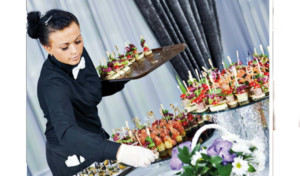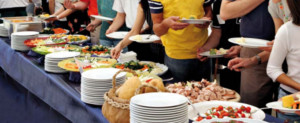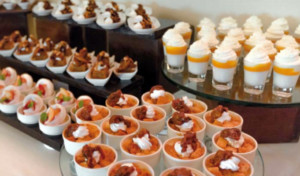Over the last decade, the catering industry in India has rapidly evolved and has become central to any large social and outdoor gathering. Functions that were earlier handled by families are now being increasingly outsourced to catering units, which often result in better arrangements and an opportunity for the family to enjoy the event. Considering the significance of social celebrations and events, the catering business is a rewarding option with a huge potential of growth. Valued at Rs. 20,000 crore, the catering industry is one of the fastest growing sectors that has seen a surge in demand across the country.
Mostly dominated by unorganized players, many of who run their business from the comfort of their homes and small establishments, the catering industry in India has maintained a 20-25 per cent growth rate year-on-year. This includes small-scale vendors along with local and national level players.
The growth in the industry can be attributed to the fact that catering services start-up costs are considerably lower and real estate doesn’t have to be in a prime location. One can work out of location that is further away but yet service the entire city. A lot of caterers are empanelled with banqueting venues, which offer them commissions.
Banks and joint venture partners are also recognising the potential of this business and are willing to offer an extended hand for establishing the business and also for its expansion.
According to the Federation of All India Caterers (FAIC), an industry body that has more than 3,000 members across 14 states, the catering industry in India is primarily spread across metros, tier 1 and tier 2 cities.
“It has definitely come a long way from the days when we had started. There is a heightened awareness of food and various cuisines. Clients demand variety in food. And they are more particular about the authenticity of ingredients, styles of cooking and presentation. They want the food customized with the rest of the theme of the event. Guests are more experimental these days and enjoy trying out new cuisines and are looking for more variety, range and innovation in food and presentation,” says Narendra Somani, President, FAIC. The festivities from October to November and weddings from November to March in India are among the best times for the catering industry. Though, the industry doesn’t rest for the remaining part of the year as well.
New emerging segment
Although weddings account for nearly 65-70 per cent of the catering segment, corporate and sporting events are fast catching up. “The scope of catering in corporate segment is now much larger. Previously, there used to be only events like product launches, conferences and updates. Now companies are organising events such as Employee Motivation day, Family day, destination conferences, etc, which require catering. The concept of destination wedding too is catching up. We have booked a palace in Italy for an upcoming wedding in December and will be fl ying down people for the same,” says G.S. Bindra of Bindra Hospitality, a 25-year-old Pune-based catering and event management firm.
 Advancement in cooking and transportation technology is fuelling the growth of the catering sector. Gas powered kitchens, which were long been favoured by caterers, is giving way to Induction as it is more environment friendly and energy efficient. This, together with the rise in gas prices, improved technology and awareness of the advantages of induction, explains why more catering units are making the shift.
Advancement in cooking and transportation technology is fuelling the growth of the catering sector. Gas powered kitchens, which were long been favoured by caterers, is giving way to Induction as it is more environment friendly and energy efficient. This, together with the rise in gas prices, improved technology and awareness of the advantages of induction, explains why more catering units are making the shift.
High tech vegetable cutting and processing machines, blast freezers, Individual quick freezing, Retort technology, combi ovens, reefer vans, etc, help reduce the labour cost, increase productivity and at the same time help to reduce the wastage of food products.
Key trends in the industry today
In a world of tough competition where business and brand names are at stake, many catering companies are flexing their creative muscles for innovative ways of catering business and social events.
“Competition within the catering industry is stiff. Every guest is different and unique. We need to have trained and professional associates to customize every event and to pick competitive prices for services and balance the guest’s budget. We need to be innovative, creative and upscale to be one of the preferred meeting venues,” says Director of Catering Sales, Westin Garden City Mumbai, Varsha Sachdeva.
The sit-down, plated dinner is not endangered, but alternatives are becoming more popular, from entire meals served on small plates, to Mongolian barbeque to dessert-only or hors d’oeuvre-only events. Guests today want to be entertained by the catering. That can be as simple as a chef who chats up the guests while serving or as complex as a menu item that foams, sizzles or bursts in some amazing way.
Here are a few catering trends that are now ruling the industry:
Customization: Clients today are way more demanding than before, believes Sanjay Vazirani who counts Ambanis, Ruia Brothers, Goenkas, Binani and the Poddars among his regular clients.
“Everybody wants their event to have the best food, services, presentation, theme-based service ware, etc. Customization is the solution. The strength of a caterer lies in being able to adapt to these varied needs. We cater to every request – right from 24-hour coffee, small eats to religious rituals such as the Chauviar which necessitates eating before sunset. We personalize to such an extent that if a vegetarian guest requests Thai food, we fly in Thai Buddhist monks who specialize in vegetarian food to cater for the event. When we catered for Gautam Adani’s son’s wedding in Ahmedabad, we sent our people to Tharat, a place in Gujarat where the Adani’s come from to understand their customs, food and tradition. We were then able to replicate it to a great extent at the wedding. For Kokilaben’s birthday celebrations in Jodhpur, we flew in chefs from Dubai for Lebanese food, Thai chefs from Thailand, chefs from Amritsar for Amritsari chole and kulche, pani puriwalla from Ambala and so on,” reveals Vazirani.
 His company Foodlink operates from a state-of-the-art 30,000 sq. ft. central kitchen and warehouse in Mumbai suburbs. “Comfort foods are still in demand, but clients expect a gourmet twist.
His company Foodlink operates from a state-of-the-art 30,000 sq. ft. central kitchen and warehouse in Mumbai suburbs. “Comfort foods are still in demand, but clients expect a gourmet twist.
Our SuperFoodRx theme breaks during corporate events help our guests recharge their body and mind. The nutritious snacks and nourishing smoothies give them the focused energy they need to work at your best,” says Sachdeva.
Regional Cooking
In a bid to re-discover their heritage, people are shifting to regional food during social events. The regionalization for a Maharastrian wedding goes down to the very region the bride or the groom come from – Kolhapur, Pune, and so on. Within the Gujarati community the food is customized to the region the host belongs to – Ahmedabad, Saurashtra, Rajkot, etc. So along with classic cities like Coorg and Mysore, the India outside the metropolis is ruling the roost in catering.
Artful Plating
We’ve all heard the saying, “you eat with your eyes first.” Caterers are taking this adage a step further with innovative food plating. Catering to events is no longer just about serving good food; it’s now about creating experiences and unforgettable memories. And hence, presentation plays a very important role. There is literally no limit to the creativity and inspiration here.
At Foodlink, there is a separate team that handles display and presentation to help add value to the overall theme of the event. The team co-ordinates with the event management team to understand the client’s vision and the event coordinators’ execution of the same, and incorporate elements from these into the display and presentation of the catering set-up.
From display tables, printed menus and napkins to the liveried service staff and table set-up, each individual area is carefully thought through to add value to the overall effect of the event.
Props and decor, when the budget allows, are often used to make a nice buffet look extraordinary.
Mini Foods
Caterers are constantly finding ways to elevate their services. Bite sized delicacies is one such effort. From bite sized burgers to desserts and even gourmet creations; you name it, caterers can make it fit in the palm of your hand. They’re interesting and quite a conversation starter plus it allows guests to be free to mingle without a large plate and cutlery bogging them down.
Adventurous Tastes
Clients are becoming a lot more adventurous, particularly when it comes to food, says Nikhil Tipnis, a Mumbai based-caterer and event planner. Caterers are indulging their taste buds with international cuisines.
“It’s not just pizza and pasta any more. Clients want Turkish, Egyptian, Korean and Vietnamese at their events. Moreover they demand these cuisines in vegetarian form which is often a challenge.”
Molecular gastronomy is no longer something only high-end caterers do. It was an experiment for caterers a few years ago, but guests who watch Masterchef want to see a few pearls and foams, at least. Internationally acclaimed chefs, well-versed in cuisines beyond the borders and in global trends are often fl own down to translate and introduce the best of culinary art from across the world for such events.
 “Be it authentic kulcha chole or the finer aspects of dim sum making, we fl y down chefs who are masters of it all. Recently, we flew down UK-based chef Stephen Gomes who specializes in molecular gastronomy for a wedding. It also helps that importing herbs, spices, cheese, wines, etc, is now very quick and easy,” explains G.S. Bindra of Bindra Hospitality, a Pune based event planner and caterer.
“Be it authentic kulcha chole or the finer aspects of dim sum making, we fl y down chefs who are masters of it all. Recently, we flew down UK-based chef Stephen Gomes who specializes in molecular gastronomy for a wedding. It also helps that importing herbs, spices, cheese, wines, etc, is now very quick and easy,” explains G.S. Bindra of Bindra Hospitality, a Pune based event planner and caterer.
Interactive Food Stations
People are now avoiding staid buffet counters and going more towards live and interactive counters, explains CEO & Executive Director deGustibus Hospitality, Anurag Katriar. deGustibus Hospitality is the company that handled many high profile events like IPL, and other international cricket matches played in Mumbai, Filmfare Awards, and many more.
Many catering firms prefer that the chefs use a variety of mobile tools and cooking stations to prepare food right out in the open at the event. This provides guests with a form of entertainment and a level of intimacy with the dish and the people preparing it.
From custom stir-fry stations to crepe stations, 2016 is seeing more and more chefs step out from the kitchen and into the spotlight to delight guests. Strolling chef stations, where the chef visits guests at the table with especially designed food trollies to prepare a meal to specifi cations, is also gaining traction.
Mix and Match Beverage Bars
This is where guests can create their own exotic drinks with unexpected offerings like ice-cubes infused with lemongrass, and even loose-leaf tea bars where guests can mix and match their favourite leaves for the perfect blend.
Challenges for the Catering Business
Running a catering business is fraught with difficulties especially in a country like India where the infrastructure is poor. Outdoor Woes Preparing food in open air (if no indoor kitchen setup is available) is one of the biggest challenges.
Outdoor Woes
 Preparing food in open air (if no indoor kitchen setup is available) is one of the biggest challenges that modern day caterers face. Sudden, unpredicted rain shower, heavy wind, etc., only add to the problem.
Preparing food in open air (if no indoor kitchen setup is available) is one of the biggest challenges that modern day caterers face. Sudden, unpredicted rain shower, heavy wind, etc., only add to the problem.
“The biggest challenge in the catering industry today is to create the necessary on-site infrastructure every day. This is cumbersome from the operational perspective, especially during the peak business months. It also entails signifi cant infusion of capital every year, other than adding to the execution cost of every event,” says Katriar of deGustibus Hospitality.
Lack of Trained Manpower and Attrition
Finding capable staff, who are fully trained and ready to take up the challenges of catering, is diffi cult. Eventually when you do get them, some of them take-off after a few months to search for greener pastures. Undertrained employees are likely to ruin an event and lead to a loss of business.
“What we need is a focused curriculum on catering and banqueting in hotel management colleges. The curriculum right now is heavily focused on hotels and restaurants. We need short-term courses, which can churn out trained staff for outdoor catering and banqueting industry,” feels Somani of FAIC.
“Being a largely unorganized segment, there are no anti-poaching laws in place like in the IT segment. This leads to large scale poaching which further hurts the industry,” he adds.
Food Inflation
The cost of food is one of the most important operating costs for a catering unit. Escalating food costs can squeeze a catering company’s operating margins. The price of critical commodities like rice, pulses, onions, oil and potatoes often increase signifi cantly due to poor farm yields, unpredictable weather patterns, and market reactions to Government farm subsidies. Inconsistent availability adds to the problem.
“We can be prepared for a steady inflation but a 300-400 per cent hike in vegetable rates is like a tsunami. Tomatoes at Rs 90 a kg a few months ago took all the profits away. The government should standardize the prices of essential commodities so we can conduct our business with ease. A restaurant can adjust menu pricing and pass the cost on to customers. But we can’t do that since we book orders for events months in advance. There is already a wholesale price index and a retail price index, which is available on the internet. But these numbers do not accurately reflect the prices that we actually pay,” says Bindra.
Many full service caterers now have clauses in their contracts allowing them to adjust prices based on market conditions, but in practice it is often challenging to go back to a client under contract and ask for a higher price.
Food Safety Regulation
The rules for food safety in India as mandated by the Food Safety and Standards Authority of India (FSSAI), has found more naysayers in the catering industry.
“There are as many as 35 guidelines mandated by the FSSAI that are not possible to follow in an outdoor venue. As a result, only 30 per cent of our membership base has taken the FSSAI certifi cation,” says Somani.
Vice President, FAIC, Yogesh Chandarana, adds that in the business of outdoor catering, most catering organisations offer their services at multiple venues, in which the caterers have little or no control.
For example, FSSAI guidelines mandate that the caterer should describe the source of water used for cooking and also get it tested from an accredited laboratory.
 “The FSSAI rules are just not conducive for the catering industry. We often work on sites that have no proper infrastructure. We have to create a kitchen in six hours. Adhering to a lot of regulation in such a situation is not possible,” believes Nikhil Tipnis.
“The FSSAI rules are just not conducive for the catering industry. We often work on sites that have no proper infrastructure. We have to create a kitchen in six hours. Adhering to a lot of regulation in such a situation is not possible,” believes Nikhil Tipnis.
The other pain point is when electricity is used in the manufacture of the food items. In this case, the caterer is expected to “state the exact HP used or sanctioned electricity load” (both conditions are difficult to satisfy if the catering contractor has no say in which venue the event is being held).
The Federation plans to make representations made to the Centre to formulate guidelines that will help in the growth of the catering industry. Though FSSAI rules might create some temporary roadblocks, many in the industry feel that it is an excellent idea which will eventually help the industry.
“It is imperative to have some food/ hygiene safety guidelines when you are dealing with the public at large. But a general lack of understanding of FSSAI rules is further hampering its implementation. No one knows the exact number of licences needed for FSSAI compliance. There is no specific website with that information. This leads people to believe that procuring them is a pain and unnecessary,” says Bindra.
Taxation Trauma
The high rise in taxes has made the catering businesses very expensive. The cost of obtaining requisite materials and staff is growing higher by the day, and adhering to government regulations is difficult.
The catering industry currently suffers from double taxation – Service Tax and VAT. This is the industry’s biggest concern since it’s largely dominated by a significant number of players from the unorganised segment. They are far more flexible on commercial aspects with clients as they don’t necessarily follow the highest degree of statutory compliances.
So what’s the solution?
“Nothing much can be done on an immediate basis but this is surely going to change soon. Firstly, I believe that all players will look at sharing the infrastructure costs. I feel that the laws will soon force the unorganised players to get more organised, and taxation will get more uniform (like GST), thus taking away their commercial flexibility/advantage. Lastly, I also feel that the consumers will realize the difference in the output quality of organized and unorganized players soon,” explains Katriar, who believes the proposed uniformity of tax rates is a brilliant idea. It will widen the tax net, which eventually can bring down the tax rates.
Valued at Rs. 20,000 crore, the catering industry is one of the fastest growing sectors that has seen a surge in demand across the country
Must Read


